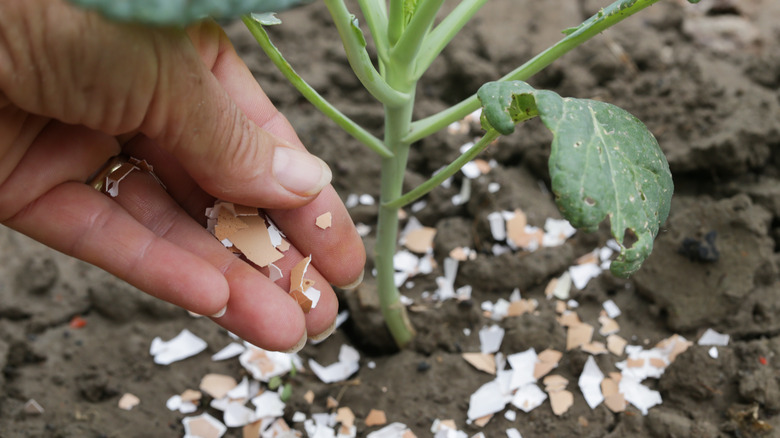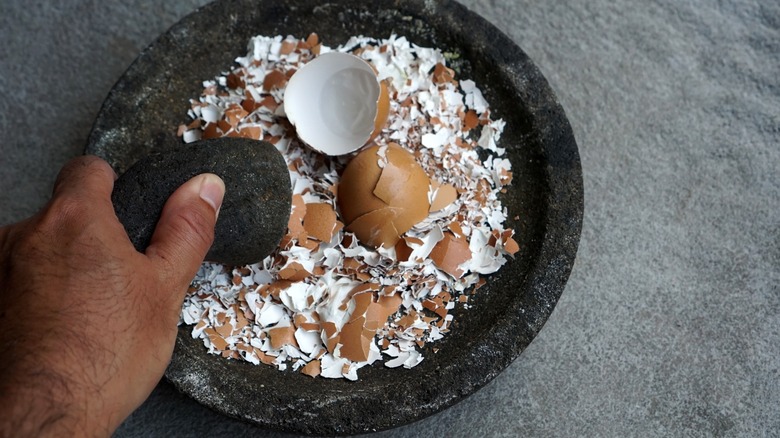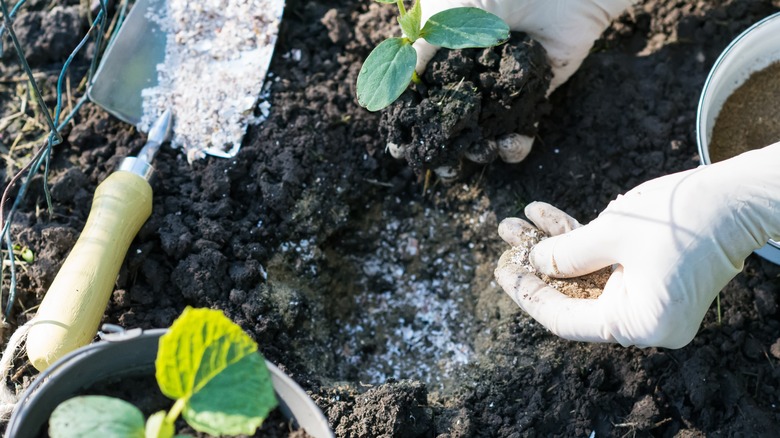When To Crush Vs Blend Eggshells Before Using Them In The Garden
Every seasoned gardener knows that eggshells can provide valuable nutrients such as calcium, magnesium, and phosphorus to the soil to aid the plants that are growing in it. But there's quite a marked difference between using crushed versus blended eggshells in your garden. While crushed eggshells are perfect for deterring pests such as snails and slugs, they won't immediately add that beneficial calcium to the soil because they take a really long time to break down and be of any benefit. That's where blended or finely ground eggshells are far more beneficial because it's easier for the nutrients to be available to the plants you're growing.
If you're in the habit of adding crushed eggshells to your compost, you'll be well aware that you'll still find pieces of eggshell in the finished compost that you add to the garden. This means that the shells haven't finished composting and hence, the nutrients are still tightly bound in the shells. While these will break down eventually, it could take years for those nutrients to be available to the plants. So essentially, you want to crush eggshells if you're using them to deter pests but you'll need to blend them if you want to provide extra calcium to your plants. Here's how to know when to use crushed or blended eggshells in your garden.
When to use crushed eggshells in your garden
One of the best ways to use crushed eggshells in your garden is as a deterrent against slugs and snails as they won't like crawling over the shells due to the sharp edges. All you have to do is wash the eggshells and let them dry. This allows you to break them down more easily and removes any problems with bacterial growth. Then, just crush them up coarsely in any way that you find the easiest. You could put them in a plastic bag and use a heavy rolling pin to smash them or utilize a mortar and pestle to crush them up.
Once you have your deconstructed eggshells, take them out to your garden and place them in a circle around the plants that you want to protect from snails and slugs. Encircle all of your young seedlings and tender annuals such as lettuce, spinach, and Swiss chard. This should help to keep the pests away from your plants and stop them from being devoured overnight. You can also add your crushed eggshells to your compost and, if you like to feed visiting birds, you might want to add crushed eggshells to your bird feeder as this will help the birds easily obtain the calcium that they need without having to forage too hard for it. Make sure you sterilize them first by boiling them for around 10 minutes or putting them in the oven for around 20 minutes before smashing them.
When to use blended or ground eggshells in your garden
If you grind your eggshells into a fine powder, the nutrients they contain will be much more available for the plants to absorb through their roots. This is particularly useful for plants that require a good dose of calcium, like tomatoes and peppers, and can also be helpful in amending the soil pH by increasing the alkalinity of the soil, much like liming does. Adding finely ground eggshells in your vegetable garden may also help to grow the crispiest cucumbers using this secret weapon from your kitchen.
To grind your eggshells into a fine powder, a coffee grinder is one of the best tools that you can use because you'll end up with a nice fine powder that is likely to dissolve much easier and add nutrients to the soil. Once again, wash your eggshells first and let them dry before you grind them up with the coffee grinder. Now you can use the powder in the garden. It's particularly useful for placing into your tomato planting holes to help prevent blossom end rot. You can even add some finely ground eggshells to your houseplants as potting soil will lose magnesium every time you water it. This is one of the reasons that your orchids will thank you for eating more eggs. It's a good idea to sterilize the eggshells first by boiling them or placing them in a slow oven so that they don't attract pests.


